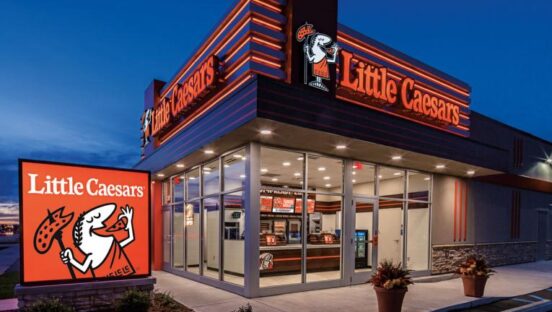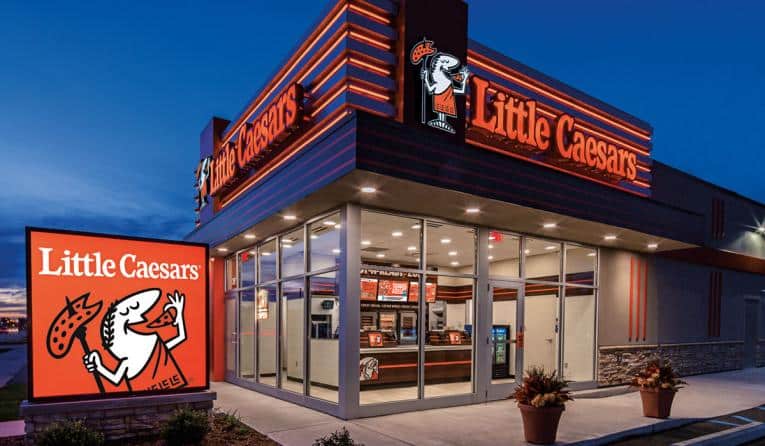Little Caesars chief development officer, Jeremy Vitaro, admits the brand can keep things close to the vest at times. The family-owned operation isn’t known to talk all that openly about its accomplishments or size—by unit count at 4,173 stores year-end 2022, Little Caesars was the third-largest pizza chain in America, only behind Domino’s (6,686) and Pizza Hut (6,561).
That’s one reason being the official pizza sponsor of the National Football League, a partnership it struck in 2022 that succeeded Pizza Hut’s three-year run (Papa Johns held the eight years prior), has signaled a dual unlock for Little Caesars.
Firstly, there’s no denying the sheer exposure that comes with linking with one of the most visible platforms in the world. The average television viewership of a regular season NFL game in 2022–2023 was 16.7 million, according to Statista. Last year’s Super Bowl reeled in 113.06 million viewers.
Coupled with the fact Little Caesars, for the first time this year, entered into five different stadiums, in New Orleans, Philadelphia, Kansas City, Pittsburgh, and Detroit, Vitaro says the marketing plus nontraditional growth exposed Little Caesars to “hundreds of thousands,” if not far more, consumers. And so, all the historic differentiators of the brand, namely its value and offbeat persona, have been thrust in front of an audience that might just be getting to know Little Caesars. It’s happening organically.
The other part, however, Vitaro says, is the NFL deal helped prospective franchisees understand “how significant the brand is,” how sizable its scale is, and the ways in which the chain cultivated mass appeal over the decades that resonates everywhere.
“It’s helping prospective franchisees, people who were thinking of investing with the brand, folks beginning to have conversations, it’s helped them understand how diverse [Little Caesars] is,” Vitaro says.
It’s important timing as Little Caesars begins webbing out into fresh territories, with a circle drawn around the whole Northeast coordinator. Call it from Washington, D.C. and Baltimore north to Boston. For operators in those areas, where Little Caesars might not have deep penetration, the NFL awareness gave Little Caesars’ national clout. “I think it’s just helped folks understand how significant we are,” Vitaro says. “And I think that would be true for any brand that partners with the NFL. But, in our case, it’s even stronger because, being family owned, we’re not necessarily always tooting or own horn. So this has been especially beneficial from a development perspective.”
The multi-year NFL partnership Little Caesars inked in 2022 a month before the start of training camp secured exclusive marketing rights to connect with the league, events, and customers. Social media games, new products, packaging, and continual promotions have run throughout.
Little Caesars began Year 2 with fee-free delivery from August 28 through September 10 and brought back the Pizza!Pizza! Pregame deal where guests who order an hour before and three hours after scheduled NFL kickoffs become eligible for perks, like 25 percent off NFLShop.com merchandise or $2 off Caesars Wings, and instant-win prizes, such as football regular season tickets or gift cards to shop at the league’s digital store. Every purchase also enters the user into a pool for a trip to Super Bowl LVIII in Las Vegas. San Francisco 49ers tight end George Kittle, New Orleans Saints defensive end Cam Jordan, and NFL analyst Ryan Fitzpatrick have starred in a series of commercials. Additionally, through a longstanding partnership with Pepsi, Minnesota Vikings wide receiver Justin Jefferson landed a role in a primetime advertisement focused on the Pizza!Pizza! Pregame promotion.
Lastly, Little Caesars connected with nine NFL teams—the Detroit Lions, Kansas City Chiefs, Los Angeles Rams, Minnesota Vikings, New Orleans Saints, Philadelphia Eagles, Pittsburgh Steelers, San Francisco 49ers, and Tampa Bay Buccaneers—for specialized branding and in-game activations.
Vitaro adds the company carried the partnership into product promotion. In early September, Little Caesars introduced a “4-Quarter Calzony” for $8.99. It’s a pizza-calzone mashup with four-different meats (pepperoni, bacon, ham, and Italian sausage) that’s topped with a buttery flavored spread, filled with mozzarella and one meat from the center.
When Little Caesars first began its NFL journey, it was on the heels of what the brand described as a stellar year with “one of the strongest pipelines” it had in a number of calendars.
That appears to have continued. The brand recently unveiled its first Queens, New York, location, and has plans for Chicago. Also, veteran multi-brand franchisees Suhel Ahmed and Saurabh Desai signed a 10-store deal to head into the Bronx and upper Manhattan by 2026. The Queens debut was part of a separate eight-store deal with another multi-unit franchise group.
Vitaro, who is based in New Jersey, says Little Caesars built out a local team ready to tackle the whitespace. And the brand plans to launch a product designed for on-the-go eating that fits the dense, urban landscape of the Big Apple.
Worth noting, too, alongside raising its profile with the NFL, Little Caesars’ decision ahead of the 2020 Super Bowl to launch delivery changed where it could go from a tangible perspective. As a strictly pickup brand, the notion of entering the heart of a major metro was a dicey concept.
Now, Little Caesars’ approach has the 2018-introduced pizza portal, a convenient locker system for customers to pick up orders, as well as last mile, third-party delivery. “That combination is changing our consumer base,” Vitaro previously told QSR. “It’s letting us play in a larger field and with different consumers that are wanting customization. So what that means for development, I think it’s giving us a lot more opportunity to go into new places—even within existing markets—than I had expected.”
Little Caesars’ growth push is also being spearheaded by VP of U.S. development Patrick Cunningham, who’s been with the brand just under a year. He came over after 16 years with Dunkin’, rising to director of operations. At Inspire Brands, the Roark Capital-backed group that purchased Dunkin’ and Baskin-Robbins for $11.3 billion in late 2020, he served as senior director of franchising. Vitaro and Cunningham spent more than 15 years together at Dunkin’.
Regardless of where the brand heads, Vitaro says, the same characteristics NFL fans are discovering will enable it to succeed—things like speed and a value preposition that’s anchored Little Caesars since it was founded on May 8, 1959, by Mike and Marian Ilitch.
For instance, it’s planning to land in New York with an $8.49 starting price point for a large pizza. “And that’s just an example of how in a new market we can communicate value and delivery value really from the start,” Vitaro says.
Of course, the chain’s hero $5.55 pepperoni pizza will be part of the picture as well. Another example of the mindset—Little Caesars raised the price 55 cents in light of inflation but threw 33 percent more pepperoni on it to balance things out.
Little Caesars’ franchising investments range from $378,700 to $1.695.5 million, with incentive programs available for veterans and first responders. Vitaro says, like the rest of quick service, construction costs, timing, and parts were a pricy and frustrating maze to navigate over the past couple of years. That’s started to ease, especially regarding equipment timing and availability, like lead times for walk-in coolers and so forth. “The outlook I think is positive,” he says. “But certainly, it can be a challenging environment. We’re fortunate and other brands are, too, but we’re fortunate that we can go smaller. We have a flexible format and we can adapt.”
Little Caesars’ value focus helped it insulate a bit, Vitaro adds. Sales have been strong. “I think it’s very, very important right now,” he says. “And part of why we’re feeling really good about the big picture.”
In addition to the Northeast corridor, Vitaro sees the Pacific Northwest, especially Seattle and Portland, as opportunities for the brand. The Carolinas as well. Some Midwestern markets, such as Kansas City, Indianapolis, and Pittsburgh, offer runway, too. For current trade areas, Little Caesars is using cell phone mapping technology to figure out the best way to infill between existing restaurants. Little Caesars prefers to sign multi-unit deals between five to 10, but remains a brand where entrepreneurs can sign on for single stores and grow alongside the company, which runs nearly 600 corporate restaurants.
“We’re excited right now about how the brand is performing and it’s a great model,” Vitaro says. “Pizza is an exciting space to be in. But we think within pizza, we’re really positioned well, and as we go into new places, like New York, we think we can take advantage of those things that are hallmarks for the brand, like convenience and value in particular.”








